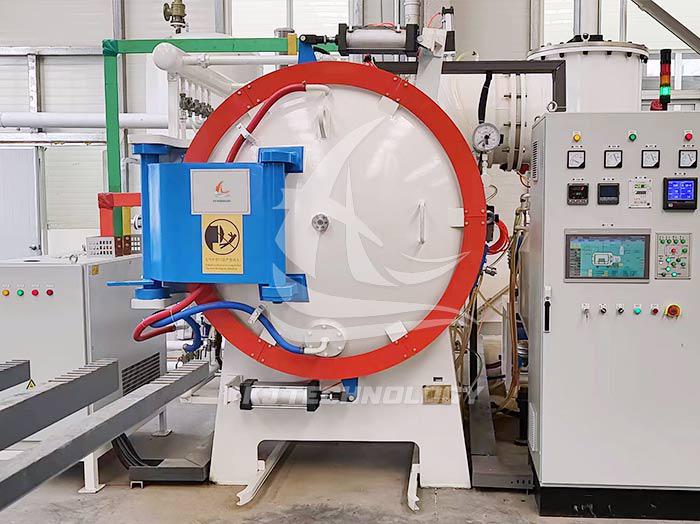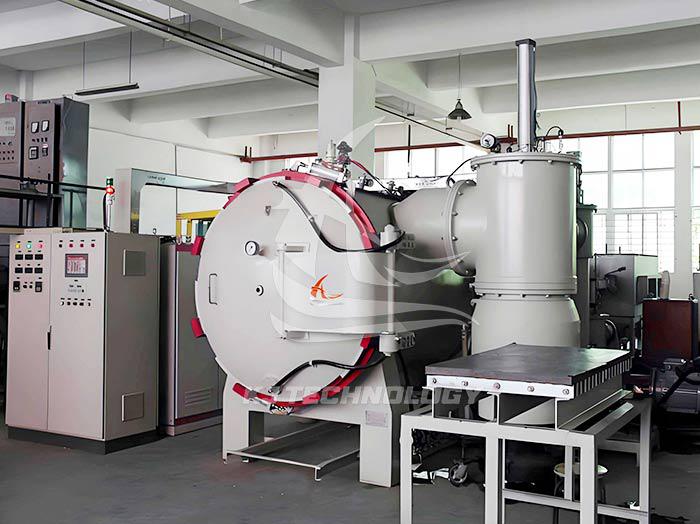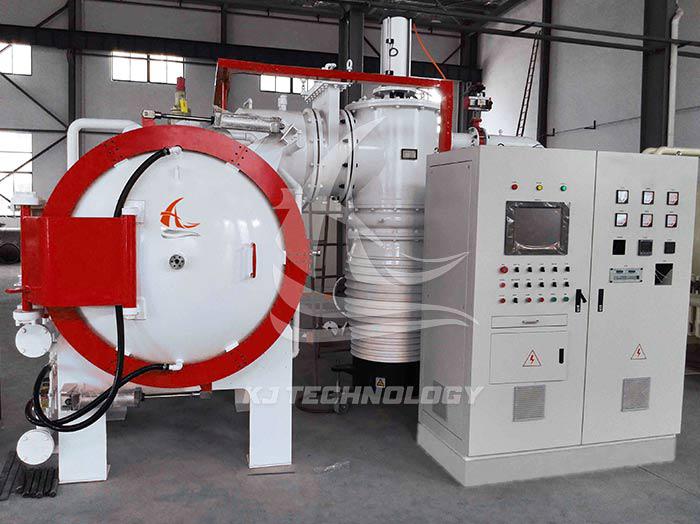What are the characteristics and advantages of high vacuum hot pressing furnace?
 07-18-2025 Author: KJ technology
07-18-2025 Author: KJ technology
The high vacuum hot press furnace combines vacuum environment control and hot press forming technology, demonstrating unique advantages in the field of material preparation. Its characteristics and advantages can be elaborated in detail from four dimensions: technical characteristics, material performance improvement, process adaptability, safety and reliability:
1. Technical features: precise control and efficient integration
Ultra high vacuum environment
Extreme vacuum degree: up to 5 × 10 ⁻⁴ Pa or below, far exceeding ordinary vacuum furnaces, completely eliminating active gases such as oxygen and water vapor, avoiding material oxidation, decarburization or hydrogen embrittlement.
Atmosphere protection: Inert gases such as argon and nitrogen can be filled to create a protective atmosphere, suitable for gas sensitive materials such as titanium alloys and rare earth materials.
Integrated hot pressing design
Bidirectional pressurization: By using a hydraulic system to apply pressure from both the top and bottom directions, the material is evenly stressed, reducing internal pores and improving density.
Rapid heating: using graphite resistance or induction heating, the heating rate can reach 20-50 ℃/min, shortening the production cycle.
Temperature uniformity: The temperature field deviation in the furnace is ≤± 5 ℃, ensuring the consistency of material properties.
Automation and Intelligence
PLC/computer control: supports preset process parameters, real-time monitoring and data storage, programmable multi-stage heating curves (such as preheating, insulation, cooling).
Closed loop feedback system: By dynamically adjusting the pressurization parameters through pressure sensors and displacement displays, precise pressure control is achieved (with an error of ≤± 1%).
2. Material performance improvement: breaking through the limits of traditional craftsmanship
Significant improvement in density and strength
Eliminating pores: Under pressure, the contact area between material particles increases, promoting metallurgical bonding and achieving a density of over 99% (ordinary sintering only 90-95%).
Mechanical performance optimization: The bending strength of hard alloys (such as WC Co) is increased by 30-50%, and the fracture toughness of ceramic materials is increased by 2-3 times.
Fine grained microstructure
Grain refinement: Pressure suppresses grain growth, obtaining nanoscale or submicron grain structure, and improving material hardness and wear resistance.
Phase composition control: Reduce the generation of impurity phases in a vacuum environment, such as avoiding the decomposition of carbides into oxides and maintaining material purity.
Feasibility of low-temperature sintering
Reduce sintering temperature: Pressure promotes particle diffusion, reducing sintering temperature by 100-300 ℃ compared to pressureless sintering, reducing energy consumption and equipment loss.
Inhibiting grain boundary migration: Slowing down grain boundary movement at low temperatures, avoiding abnormal grain growth, and improving material uniformity.
3. Process adaptability: meet diversified material requirements
Powder metallurgy field
Hard alloy: Preparation of high-density tungsten cobalt (WC Co) alloy for high wear resistance scenarios such as cutting tools and molds.
Metal based composite materials, such as aluminum based silicon carbide (Al SiC), achieve strong bonding between metal and ceramic through hot pressing, improving thermal conductivity and strength.
Preparation of functional ceramics
Transparent ceramics: sintering aluminum oxide (Al ₂ O3), aluminum nitride (AlN), etc. under vacuum to achieve high transmittance (>80%) and thermal conductivity.
Structural ceramics: such as silicon carbide (SiC) and silicon nitride (Si ∝ N ₄), with a bending strength of 800-1000MPa after hot pressing, suitable for high-temperature bearings and turbine blades.
Nanomaterial synthesis
Nanoparticle solidification: hot press nano powder under vacuum to avoid agglomeration and maintain material activity, which is used in catalyst, magnetic materials and other fields.
Gradient material preparation: By layering pressure and temperature control, gradient changes in material composition or structure are achieved to meet special performance requirements.
Composite material forming
Metal ceramic composite: such as titanium based titanium carbide (Ti TiC), which combines metal toughness and ceramic hardness after hot pressing, is used for aerospace components.
Fiber reinforced composite: Carbon fiber, ceramic fiber, and metal matrix are combined through hot pressing to achieve good interface bonding and improve fatigue resistance.
4. Safety and reliability: ensuring long-term stable operation
Multiple security protections
Overtemperature alarm: When the temperature exceeds the set value, the heating power supply will be automatically cut off to prevent equipment damage.
Overpressure protection: Activate the pressure relief valve when the pressure exceeds the rated value to prevent mold or furnace rupture.
Leakage protection: Real time monitoring of circuit insulation performance, immediate power-off and alarm in case of leakage.
Modular design
Quick maintenance: The furnace body, heating system, pressurization system and other modules are independently designed and can be quickly replaced in case of failure, reducing downtime.
Standardized interface: compatible with different specifications of molds and heating elements, reducing equipment upgrade costs.
Long lifespan and low maintenance
High temperature resistant materials: The inner wall of the furnace is made of graphite, alumina ceramics, etc., which are corrosion-resistant and have a lifespan of up to 5-10 years.
Water cooling system protection: Circulating cooling of heating elements and furnace body to prevent local overheating and extend equipment service life.
5. Typical application cases
Aerospace: Hot pressed carbon/carbon composite material (C/C), used for rocket nozzles and brake discs, capable of withstanding high temperatures above 3000 ℃.
Semiconductor industry: Preparation of high-purity alumina ceramic packages to meet the stringent requirements of chips for thermal expansion coefficient and airtightness.
Biomedical: Hot pressed sintered bioceramics (such as hydroxyapatite), used for artificial joints, with both biocompatibility and mechanical strength.








